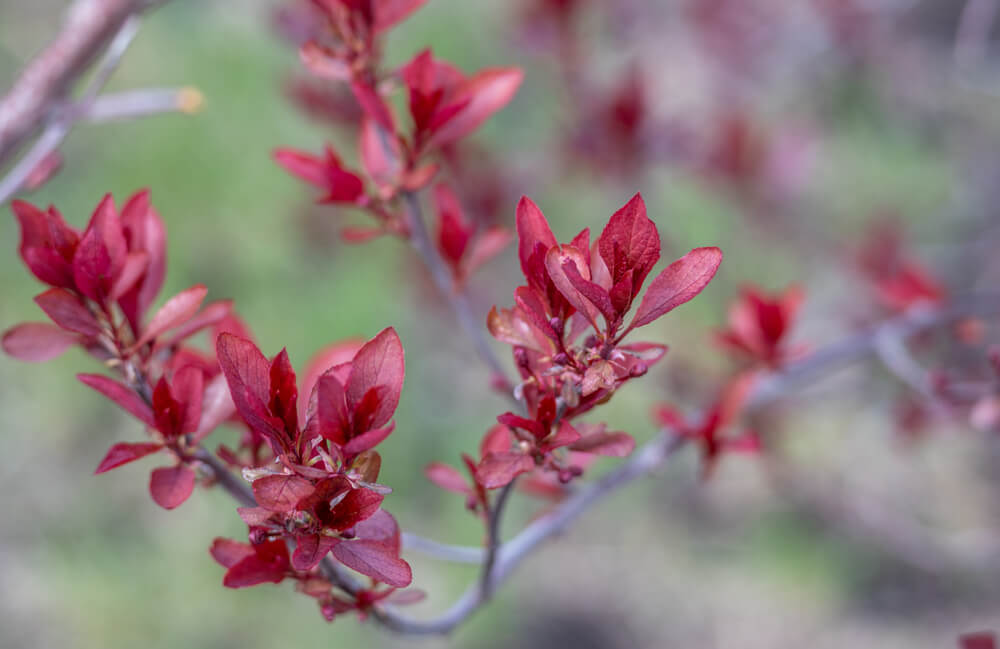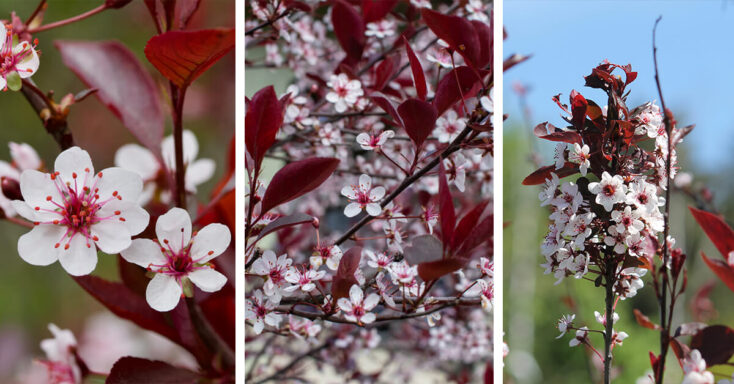You’re walking along and see a pretty medium-sized shrub. It’s summer, and the bush has a bevy of white-pink flowers. The purplish leaves seem to frame each blossom. Congratulations! You’ve just encountered a Purple Leaf Sand Cherry. It’s so pretty you might want to learn how to grow and care for one in your landscape.
Sand Cherry Trees are kissing cousins to plums. The Cherry Plum was part of the hybrid process. The Purple Leaf Sand Cherry appears as an ornamental shrub or small tree, depending on pruning. At maturity, it measures 8×8’. It’s outstanding with 2-inch red, maroon, or purple leaves.
If you live in USDA zones 2-8, the Sand Cherry will grow for you so long as they have well-drained soil. The charming pink buds become white-pink flowers in spring, slowly transforming to bronze-green come autumn. Many small birds use the tree for food and as nesting grounds.
Key Takeaways
- Purple Leaf Sand Cherries prefer slightly acidic, loamy soil.
- Sand Cherry Tree’s stems peel back and ooze sap, so don’t wear white!
- The Sand Cherries’ branches are sensitive to frost.
- The average lifespan for Purple Leaf Sand Cherry Trees is 10 years.
- A Sand Cherry tree isn’t suitable for container gardening due to its wide-spreading roots.
8 Suggestions for Growing Purple Leaf Sand Cherries Successfully
1. When to Plant
Purple Leaf Sand Cherries aren’t overly fussy about when you put them in the ground. In four-season environments, spring is a good choice. This gives the tree establishment time before winter. If you must plant in the fall, amend the soil with mulch and fertilization.
Is it a Tree or a Bush? This particular plant bears the word “Tree” in its name. Nonetheless, it looks more like a shrub. In reading descriptions of the Sand Cherry, most people lean toward it being a bush. You can, however, prune it into a short-trunked tree.
2. How to plant
Should I put it there? How about there? The Purple Leaf Sand Cherry adapts to a variety of growing conditions. They do appreciate a regular dose of sunshine (8 hours), and partial shade is fine. The average tree grows to about 7 feet tall. When planning your landscape, keep the size in mind.
Make sure you have an area that stays “moist” but not “wet.” Clay soils are not an issue. Dig your hole twice as wide as the root ball. For depth, not more than the root ball is necessary.
When you first put it in the ground, the Purple Leaf Sand Cherry leaves begins with an oval shape. Over time, it arches, giving you other options for lawn art.
3. The Care & Keeping of Purple Leaf Sand Cherry Trees

Caring for your Purple Leaf Sand Cherry isn’t difficult. They need:
- Fertilizer: Every spring, give your Sand Cherry a pick-me-up. Use a general all-purpose product.
- Pruning: Prune as needed after the spring bloom. Take off the oldest stems first, along with any damaged or dead branches.
- Soil: Normal soil with a little gravel or sand. pH 7-8.5
- Temperature: Sand Cherries shrug off most temperature changes. They will grow more slowly in chilly weather and possibly yield fewer blossoms.
- Water: This plant is not drought tolerant. It needs regular watering. About once a week works, but if it’s been hot and dry for a while, give it more. Two other times the Sand Cherry needs more water is the first growth season and after it’s transplanted. Water until the soil surface stops draining off.
- You can make green dye from its leaves and grey dye from the fruit.
- Leaves become fodder for livestock.
- Sand Cherry trees stabilize soil on roadsides.
- This tree is a rootstock for Japanese plums, peaches, apricots, and plums.
4. Purple Leaf Sand Cherry in Landscaping
Purple Leaf Sand Cherry Trees create a stunning contrast in a garden or on a lawn. It’s ideal for urban gardens because of its slight size. Add one to a water feature or hardscaping. Plant several for a unique hedge with great texture.
If you have an odd-shaped blank spot in the yard, the Sand Cherry is an ideal solution. Couple it with yellow tulips and orange marigolds. This plant comes up on favored landscaping additions repeatedly.
Up We Go: The average Purple Leaf Sand Cherry grows at a medium pace. Depending on conditions, it will increase in height by 13 to 24 inches. The slower rate reflects a tree not getting as much sun as it would like.
5. Propagating Purple Leaf Sand Cherry Tree
You could gather seeds from any Sand Cherry you currently have. Just know it’s highly unlikely the new tree would look like the parent. A better approach (and faster) is using the suckers growing at the tree’s base.
During the early summer, dig out a few suckers looking for one(s) with the most roots. Get a large pot and plant the sucker. Water it well. Move the pot into indirect sunlight. Give your new sprout a month before you move it into your landscape.
Symbolism and Meaning: Because the Sand Cherry is a relative newcomer to the gardening scene, it has little in the way of symbolism attached. We can, however, consider the bush’s color for insights. Purple is an emblem of creativity, wealth, introspection, self-awareness, and spirituality. It corresponds to the Crown Chakra, which supports harmony.
6. The World of Prunus

The genus of Prunus to which the Purple Leaf Sand Cherry belongs has 400 species, many of which yield edible fruit. Known as a drupe, these are stone fruits. Many of these trees self-pollinate. Just sit back and wait for the harvest. Other members of this family include:
- Almond (in this case, we eat the nut, not the covering)
- Apricot
- Blackthorn (used in sloe gin)
- Chinese Plum
- Japanese Flowering Plum (the National flower of Japan)
- Nectarine
- Peach
- Sweet Cherries (like Bing)
This member of the Prunus family is rapidly reaching the endangered state. Pharmaceutical companies harvest it to manufacture drugs for prostate cancer. The demand is great in that 50% or more of the American and European population among men suffer from some type of prostate problem. The bark from which the medicine comes at the cost of $30 per pound.
7. Common Pests & Plant Diseases
Japanese beetles cause significant damage to the purple leaves of the sand cherry. Other insects attracted to the tree include scale, spider mites, leafhoppers, and tent caterpillars. Signs of trouble include lacy holes in the leaves. The foliage may turn brown and wither, too.
Disease-wise, there’s honey fungus, leaf curl, bacterial leaf scorch, and powdery mildew. Any such disease decreases the tree’s lifespan.
A Sweet Drink: Mix sand cherry juice with yogurt, orange, papaya, mango, kiwi, and ginger for a refreshing smoothie that’s even good for you! Of course, you’ll need the sand cherry juice to get started. Put one pound of cherries with ¼ cup of water in a stainless pan. Simmer them for 15 minutes. When cool, strain the juice through the cheesecloth and you are good to go.
8. Purple Leaf Fruit in the Kitchen
Beverages aren’t the only way to use Purple Leaf Cherry fruit in the kitchen. Its unique flavor suits savory and sweet dishes. When you make the juice into a sauce, for example, it becomes a finishing drizzle ideal for salmon.
Mind you, when most people hear “cherry” they think of dessert. Sand Cherry syrup goes with cheesecake, pie, over ice cream, and you can even make it into popsicles. One of the easiest recipes you can try at home is making jelly.
- 3 ½ cups sand cherry juice
- 3 ½ cups sugar (white)
- 1 package (1.75 oz) pectin powder
- In a non-reactive pan, combine the juice with pectin. Heat it to a hard boil.
- Add sugar and stir.
- Continue with a rolling boil for one minute (keep stirring).
- Remove from the stovetop.
- Pour into jelly jars, leaving ¼ “open at the top.
- Use a water bath method for sealing the jars.
8 Particulars of Purple Leaf Sand Cherry Care

At first, it’s disappointing that the Purple Leaf Sand Cherry cannot be among your exotic indoor plants. Even so, the impact this tree has on your lawn or garden elicits “wows” from visitors.
Once integrated into your array, the Purple Leaf Sand Cherry doesn’t create many problems for the home gardener / cultivator. Make sure it gets sun, water, and fertilizer once a year, and that’s pretty much the whole of it.
What more could you ask for? Beauty and simplicity all in one tree.
Frequently Asked Questions About Purple Leaf Sand Cherry
How big do purple leaf sand cherry get?
In prime growing conditions, Purple leaf sand cherries can grow up to 10 feet tall. That size becomes more impressive when you realize the spread of the bush is between 5 and 7 feet. Some circumstances, like poor lighting or disease, can stunt the tree’s growth.
What are the cons of purple leaf sand cherries?
By far, the biggest con of Purple Leaf sand cherries is the ooze they create. It’s called gummosis. The tree responds to physical injuries and other stressors. Ooze means your tree isn’t healthy. Perhaps the location doesn’t have proper drainage. Injuries from weather may also leek, becoming an easy mark for insects.
Can you eat purple leaf sand cherry? Is the tree plant pet safe?
Sand Cherry is a people's food, not a pet food. While small amounts may create an upset tummy. In larger amounts, the Sand Cherry is toxic to your cats and dogs. Humans, however, are not eating the Sand Cherry pit. The fruit is quite consumable and delicious in various dishes.



